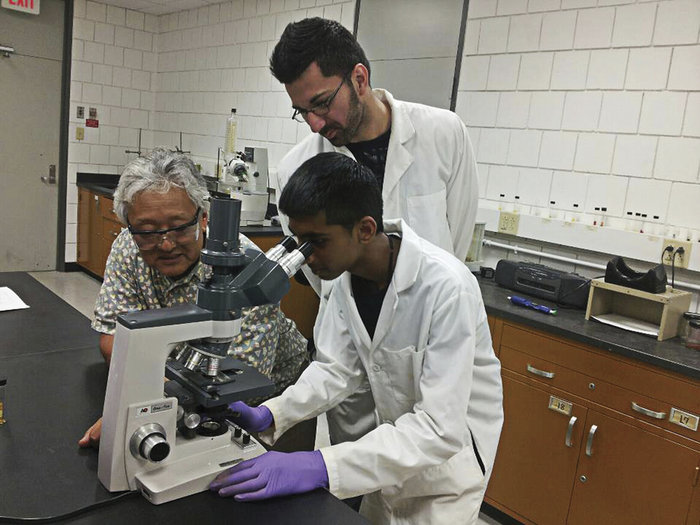Anyone who chooses to walk the path of scientific research will encounter exhilarating moments of breakthrough and discovery. But they will also have to deal with very many moments of disappointment, when an experiment – despite all the best efforts – has not worked out as planned.
It’s a lesson few budding scientists learn in high school. But it is one of the many lessons 28 high school students – including Dickinson High School’s Jay Patel – are learning this summer as part of Liberty Science Center’s Partners in Science Program.
“Research is very tough. I tell [the students], you’re lucky if you get a result in one summer,” said Prof. Kenneth Yamaguchi, chairman of the chemistry department at New Jersey City University (NJCU), who has taken Patel into his laboratory this summer as part of the Partners in Science Program.
“If researchers could get results in two or three months,” he said, “we’d know everything there is to know by now. That’s the nature of the beast, it’s a never-ending story. Those of us who have been doing this a while know that. It’s something the students are learning.”
Now in its 26th year, the Partners in Science Program pairs rising high school juniors and seniors with university professors and gives them an opportunity to work in a professional-level lab environment. The eight-week summer internship exposes these students to advanced research and some of the cutting-edge questions and methodology contemporary scientists are exploring.
“What we do is we field the applications from students and find places in professional labs for the students to work in,” said Elizabeth Romanaux, Liberty Science Center’s director of communications.
Approximately 600 students from the tri-state-area have participated in the program since its inception, according to Romanaux.
“It’s a great opportunity for them to get hands-on experience,” Yamaguchi said.
X-ray marks the spot
This summer, Patel and another student placed in Yamaguchi’s lab are trying to determine the chemical structure of a compound.
1. “I created a nickel compound from a Schiff-base ligand [an ion or molecule that forms a coordination complex by binding to a metal atom]. I crystallized that and ran it through an X-ray machine,” said Patel, who will be a junior at Dickinson High in the fall. He said he is now trying to verify that what he thought he created is, indeed, what he has on his hands.
Patel said he is unsure what he plans to study in college, but knows he wants to do something “in the medical field” and is currently leaning towards research.
“When you make something, how do you know if what you set out to make is really what you made?” Yamaguchi asked rhetorically. “What they’re doing is using X-ray diffraction, which is a way to determine the structure of groups of atoms.”
Patel and Yamaguchi further explained that by using X-ray beams scientists can get two-dimensional images of crystals that pinpoint and map out every atom that’s a part of the crystal. X-ray diffraction helps scientists better understand the chemical make-up of molecules.
“This is a technique you usually don’t get until graduate school – if you get it all,” noted Yamaguchi, whose own background is in analytical chemistry. “The most difficult part is not the technique. What’s difficult is you have to get an actual single crystal molecule.”
Patel, his research partner, and an NJCU student mentor who Yamaguchi has assigned to assist with the pair have been working on this project four days a week since June. The lab component of Patel’s internship will continue through early August.
Patel said that while Dickinson High School is often criticized for its overcrowding and the occasional rowdiness of its students, “Their research program is really good. Not a lot of people are involved in it. It’s something that more people should take advantage of.”
Rounding it out
In addition to his lab experience, Patel and the other Partners in Science interns also participate in regular workshops that enhance their technical writing and public speaking skills. Both skills are necessary since professional scientists like Yamaguchi are expected to conduct research and publish and present their findings.
In keeping with the program’s focus, the Partners in Science students are required to write a paper on their summer lab work and must then present their work to their peers in late August.
Students enrolled in the program, which is supported by the Provident Bank Foundation and other funders – earn a $1,000 stipend.
“The reason for the stipend is we want the program to be available to students who have to earn money over the summer,” Romanaux said. “There are students who can’t afford not to work over the summer and we’d rather have them be in a program like this than flipping burgers somewhere.”
Liberty Science Center offers the Partners in Science Program annually each summer, with applications typically due in the early part of the year. For more information regarding the 2013 Partners in Science Program, contact Ruben Rosario, associate director of lab-based programs at Liberty Science Center, at rrosario@lsc.org.
E-mail E. Assata Wright at awright@hudsonreporter.com.
